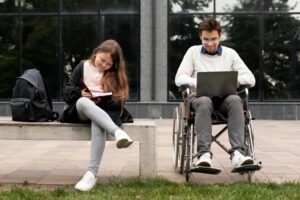Is my digital infrastructure accessible and inclusive?
Materials
1. Introduction to Digital Infrastructure
In the ever-evolving landscape of higher education, digital infrastructure has emerged as the cornerstone of modern teaching and learning. This comprehensive guide delves into the multifaceted realm of digital infrastructure, exploring its components, significance, and transformative potential within the academic sphere. From understanding the diverse array of accessibility tools to harnessing the power of innovative technologies, this resource equips university teachers and higher education staff with the knowledge and strategies needed to create inclusive and dynamic learning environments (Liu, 2021).
Through practical examples and case studies, this guide illuminates the path toward digital inclusivity, addressing challenges, showcasing successful implementations, and offering actionable tips for integrating technology into pedagogical practices. Whether you’re seeking to enhance accessibility for diverse learners, leverage cutting-edge tools like virtual reality, or ensure equitable internet access for all, this resource serves as a compass for navigating the digital landscape of higher education.
In the following chapters, we will explore the core elements of digital infrastructure, beginning with a foundational understanding of its components and their interconnectedness. We will then delve into the critical role of accessibility tools in fostering inclusivity, followed by an examination of the diverse equipment and technologies that are reshaping the educational landscape. Finally, we will address the imperative of internet access, exploring strategies to ensure equitable connectivity for all learners (Ordóñez de Pablos, et al., 2019).
Join us on this journey as we unravel the complexities of digital infrastructure and empower educators to shape a more accessible, inclusive, and future-ready academic landscape.
1.1. Defining Digital Infrastructure:
Digital infrastructure, in the educational context, encompasses a broad spectrum of interconnected components that form the backbone of technological advancements within the academic sphere. From physical hardware such as servers, computers, and network systems to the software that facilitates communication, collaboration, and data management, the definition of digital infrastructure spans a rich tapestry. Understanding this multifaceted landscape is fundamental for educators seeking to navigate the complex intersection of technology and pedagogy.
The contemporary university is no longer confined to the physical classroom; instead, it extends into the digital realm, creating an interconnected ecosystem, where information flows seamlessly across virtual boundaries. Learning management systems, cloud computing, and communication platforms serve as integral components of this digital infrastructure, facilitating not only the dissemination of knowledge but also fostering collaborative learning environments that transcend geographical constraints.
1.2. Importance in the Context of Education:
The significance of digital infrastructure in education cannot be overstated. It serves as the underlying framework that supports and propels the dynamic nature of modern teaching and learning. For educators, a robust digital infrastructure means more than just efficient management of administrative tasks; it opens the gateway to innovative teaching methodologies, personalized learning experiences, and the cultivation of a technologically adept generation of students.
In the context of higher education, where the pursuit of knowledge is as diverse as the student body, digital infrastructure becomes the great equalizer. It ensures that educational resources are accessible to all, irrespective of physical location or individual learning needs. Moreover, it lays the foundation for inclusive education, where diversity is not only acknowledged but celebrated through tailored approaches that cater to the varied ways in which students engage with content (Ordóñez de Pablos, et al., 2019).
1.3. Navigating the Digital Landscape:
As we navigate the digital landscape, it becomes evident that a nuanced understanding of digital infrastructure is crucial for educators to harness its full potential. The journey begins with comprehending the interconnected web of hardware and software that constitutes this infrastructure. From the servers housing vast repositories of educational content to the software applications that facilitate seamless communication, educators must navigate this terrain with confidence to harness its transformative power (Liu, 2021).
Beyond the technical facets, educators need to grasp the philosophical underpinnings of digital infrastructure in education. It embodies the commitment to providing equitable learning opportunities to all students, regardless of socio-economic backgrounds or geographical locations. Digital infrastructure empowers educators to transcend traditional barriers, bringing education to the fingertips of those who may have previously been excluded from the academic discourse (Ordóñez de Pablos, et al., 2019).
In conclusion, this microlearning unit sets out to demystify the world of digital infrastructure for university teachers and higher education staff. It invites participants to embark on a journey of discovery, where the fusion of technology and education creates a fertile ground for innovation and inclusivity. As we delve into the subsequent chapters, each facet of digital infrastructure will be explored, unraveling its intricacies and unveiling the opportunities it presents for creating a more accessible and inclusive educational landscape (Jose, 2021).
2. Accessibility Tools
In the dynamic landscape of education, the quest for inclusivity has become an overarching principle, underscoring the need for accessibility tools to ensure that every learner, regardless of individual differences, can fully participate in the educational journey. This extended exploration will delve into the multifaceted realm of accessibility tools, illuminating their significance, practical applications, and transformative potential within the educational sphere.
2.1. Understanding Accessibility Tools:
Accessibility tools are a diverse set of applications, software, and devices meticulously designed to bridge the gap between diverse learning needs and the educational content or platforms. At their core, these tools aim to break down barriers, providing a more equitable and inclusive learning experience for individuals with disabilities, varying learning styles, or other specific requirements. For university teachers and higher education staff, familiarity with these tools is not merely an asset; it is an imperative aspect of fostering an environment that embraces diversity and supports every learner on their educational journey.
2.2. The Landscape of Accessibility Tools:
The landscape of accessibility tools is as vast and varied as the diversity of learners they aim to serve. Screen readers, for instance, are pivotal tools for individuals with visual impairments, converting on-screen text into synthesized speech. Captioning tools, on the other hand, cater to learners with hearing impairments by providing text equivalents for audio content. Adaptive technologies, including voice recognition software and alternative input devices, extend the reach of education to individuals with motor impairments.
Moreover, the spectrum of accessibility tools extends beyond physical disabilities. Cognitive and neurodivergent learners benefit from tools such as text-to-speech software, mind mapping applications, and customizable fonts, allowing for personalized learning experiences that cater to individual preferences and processing styles.
3. Equipment and Technology
The integration of diverse equipment and technology has become a linchpin in shaping innovative and inclusive learning environments. This comprehensive exploration will delve into the multifaceted realm of educational equipment and technology, examining their pivotal role, practical applications, and transformative potential within the context of higher education (Jose, 2021).
3.1. The Kaleidoscope of Educational Tools and Technologies:
Educational equipment and technology constitute a kaleidoscope of resources designed to enhance the teaching and learning experience. From traditional tools like projectors and interactive whiteboards to cutting-edge technologies such as virtual reality (VR) and 3D printing, the educational landscape is a rich tapestry of possibilities. For university teachers and higher education staff, navigating this diverse array is not merely a matter of technological proficiency; it is an endeavor to harness the transformative power of these tools to create dynamic and engaging learning spaces.
3.2. Practical Applications of Educational Tools:
This unit seeks to unravel the practical applications of a myriad of educational tools within the higher education context. Interactive whiteboards, for instance, transcend the limitations of traditional chalkboards, fostering dynamic and collaborative classrooms. These boards facilitate real-time engagement, allowing educators to integrate multimedia content seamlessly and encouraging active participation from students.
Simulation tools and virtual laboratories provide hands-on experiences in disciplines where physical labs may be constrained. Whether exploring complex scientific phenomena or conducting business simulations, these technologies offer immersive learning opportunities that transcend the boundaries of physical space.
3.3. Innovative Technologies Shaping Higher Education:
As technology continues to advance, higher education is at the forefront of adopting innovative solutions that redefine the teaching and learning paradigm. Virtual Reality (VR) and Augmented Reality (AR) are prime examples of transformative technologies that transport learners to simulated environments, enabling experiential learning in fields ranging from history to healthcare. These immersive technologies not only captivate the attention of students but also foster a deeper understanding of complex concepts (Liu, 2021).
Moreover, Learning Management Systems (LMS) have become indispensable tools for educators, serving as centralised platforms for course materials, communication, and assessment. These systems streamline administrative tasks, allowing educators to focus on delivering impactful and personalised learning experiences (Samarakkody, et al., 2022).
3.4. Empowering Educators through Technology Integration:
The significance of educational tools and technology extends beyond the immediate applications within the classroom; they empower educators to be proactive architects of dynamic and inclusive learning environments. As participants engage in the practical exercise and reflect on their experiences, they cultivate a mindset that values technology not as a mere supplement but as a transformative force that amplifies the educational experience (Samarakkody, et al., 2022).
In conclusion, educational equipment and technology are not mere gadgets in the educational toolkit; they are enablers of a profound shift in pedagogical approaches. As we navigate this module, participants will not only acquire technical proficiency but will also embark on a journey of mindset transformation, paving the way for a more innovative, inclusive, and future-ready higher education landscape.
4. Internet Access for Inclusive Education
In the digital age, the democratization of education hinges on universal and inclusive access to the internet. This expanded exploration will delve into the critical role of internet access in fostering inclusivity within higher education. From understanding the importance of free internet access to exploring strategies for promoting inclusivity through connectivity, this module seeks to illuminate the transformative potential that equitable internet access holds for diverse learners (Liu, 2021).
4.1. The Imperative of Internet Access:
Internet access is the linchpin that connects learners to a vast repository of knowledge, collaborative opportunities, and interactive learning experiences. For university teachers and higher education staff, recognizing the imperative of internet access is not just an acknowledgment of the ubiquitous role of technology; it is a commitment to dismantling barriers and ensuring that every student has an equal opportunity to thrive in the digital academic landscape (Ordóñez de Pablos, et al., 2019).
4.2. Importance of Free Internet Access:
At the heart of this unit lies a deep exploration of the importance of free internet access in higher education. The internet, often referred to as the information superhighway, is the gateway to a plethora of educational resources, research databases, and collaborative platforms. However, the digital divide remains a formidable barrier, with socio-economic factors often determining the extent of an individual’s access to these virtual learning spaces (Jose, 2021).
Free internet access becomes a catalyst for inclusivity, removing financial constraints that may hinder certain students from fully engaging with online educational materials. By delving into the significance of making the internet freely accessible, educators can actively contribute to creating an environment where every student, regardless of economic standing, can participate fully in the digital academic realm (Jaeger, et al. 2012).
4.3. Strategies for Promoting Inclusivity Through Connectivity:
While recognizing the importance of free internet access is foundational, understanding and implementing strategies for promoting inclusivity through connectivity is equally crucial. This section will delve into proactive measures that educators can take to bridge the digital divide and ensure that students from diverse backgrounds have equitable access to online learning resources (Jaeger, et al. 2012).
Addressing infrastructural challenges, such as limited broadband availability in certain regions, requires creative solutions. Educators can explore partnerships with local internet service providers, advocate for community Wi-Fi initiatives, or collaborate with institutions to establish dedicated internet access points. By actively engaging in these strategies, educators become champions of inclusivity, proactively dismantling barriers that hinder universal access to educational opportunities (Samarakkody, et al., 2022).
4.4. Empowering Learners Beyond Geographical Constraints:
The transformative potential of internet access extends beyond the physical boundaries of the classroom. For learners in remote or underserved areas, access to the internet becomes a gateway to a world of educational possibilities. Virtual classrooms, online libraries, and collaborative platforms enable students to connect with peers and educators globally, fostering a sense of belonging and expanding their horizons beyond geographical constraints (Samarakkody, et al., 2022).
Moreover, free internet access empowers learners to engage with a myriad of online courses, workshops, and open educational resources. This democratisation of educational content ensures that students can pursue diverse learning paths tailored to their interests and career aspirations, irrespective of their geographical location (Jaeger, et al. 2012).
5. Case Study: Digital Inclusivity in the University Environment
The case study on digital inclusivity in the university environment offers a deep dive into the practical implementation of strategies, challenges faced, and lessons learned in the journey toward fostering a digitally inclusive educational setting. By examining a specific university’s experiences, this module aims to provide valuable insights for educators and higher education staff seeking to navigate the complex terrain of digital inclusivity (Ordóñez de Pablos, et al., 2019).
5.1 Context and Background:
In this detailed case study, we focus on University of Illinois at Urbana-Champaign, a large-sized institution that embarked on a deliberate journey to enhance digital inclusivity within its academic landscape. The university, like many others, recognized the growing importance of creating an environment where technology serves as an equalizer rather than a barrier (Jose, 2021).
The institution found itself at a juncture where the traditional modes of teaching were increasingly intertwined with digital tools and platforms. However, this shift brought to the forefront the need to ensure that all students, regardless of their backgrounds or abilities, could seamlessly access and participate in the digital learning ecosystem.
The University of Illinois at Urbana-Champaign initiated a series of targeted initiatives to address digital inclusivity comprehensively. These initiatives spanned various aspects of the academic environment, acknowledging the diverse needs of their student population. Among the key areas of focus were:
5.1.1. Accessible Course Content: The university undertook a systematic review of course materials to ensure they adhered to accessibility standards. This involved providing alternative formats for textbooks, captioning multimedia content, and utilizing screen-reader-friendly design principles.
5.1.2. Technology Accessibility Standards: Recognizing the importance of universally designed technology, the university established accessibility standards for all digital tools and platforms used in the academic setting. This extended to the learning management system, online collaboration tools, and any software employed in the learning environment.
5.1.3. Faculty Training and Support: the University of Illinois at Urbana-Champaign recognized that faculty play a pivotal role in implementing digital inclusivity. As such, they invested in training programs to equip educators with the skills and knowledge needed to create accessible digital content, leverage inclusive teaching methodologies, and effectively utilize assistive technologies.
5.1.4. Student Support Services: A dedicated support system was established to assist students with diverse needs. This included providing access to assistive technologies, offering personalized support plans, and creating a culture of awareness where students felt comfortable seeking assistance.
5.2 Challenges Encountered:
The journey toward digital inclusivity was not without its challenges. The University of Illinois at Urbana-Champaign encountered various hurdles that required thoughtful navigation and adaptation of their strategies. Some of the notable challenges included:
5.2.1. Infrastructure Limitations: The university faced infrastructure challenges, including outdated technology and limited connectivity in certain areas. Overcoming these limitations required strategic investments in upgrading technology and advocating for improved internet access.
5.2.2. Cultural Shift: Implementing digital inclusivity initiatives necessitated a cultural shift within the institution. Convincing stakeholders of the value of these changes and fostering a collective commitment to inclusivity required persistent communication and engagement efforts.
5.2.3. Resource Allocation: While the university recognized the importance of digital inclusivity, allocating resources, both financial and human, posed a challenge. Prioritizing inclusivity initiatives within budget constraints required strategic planning and advocacy.
5.3 Outcomes and Impact:
The case study delves into the outcomes and impact of these digital inclusivity initiatives. Through a combination of well-executed strategies and a commitment to continuous improvement, the institution witnessed several positive outcomes:
5.3.1. Improved Student Engagement: The inclusive digital environment led to increased student engagement. Students with diverse needs reported feeling more included and empowered to actively participate in digital learning activities.
5.3.2. Enhanced Learning Outcomes: The implementation of accessibility standards positively impacted learning outcomes. The diverse student body found it easier to access course materials, participate in online discussions, and engage with interactive content.
5.3.3. Faculty Empowerment: Faculty members, equipped with the necessary skills and support, reported increased confidence in utilizing digital tools to create inclusive learning experiences. This empowerment contributed to a more dynamic and adaptable teaching environment.
5.3.4. Cultural Transformation: Over time, the institution experienced a cultural transformation where digital inclusivity became embedded in the ethos of the university. This shift was reflected in the collective mindset of students, faculty, and administration.
5.4 Lessons Learned and Future Directions:
The case study concludes by extracting valuable lessons learned from this case study and outlining future directions for sustained digital inclusivity. It explores the importance of flexibility in adapting strategies, the need for ongoing training and awareness programs, and the role of technology in driving continuous improvement (Samarakkody, et al., 2022).
The lessons learned and future directions provide a roadmap for other institutions seeking to embark on a similar path toward digital inclusivity. By understanding the nuances of this case study, educators and higher education staff can glean practical insights that inform their own initiatives and contribute to the ongoing conversation about creating truly inclusive digital learning environments.
6. Some practical tips
Practical Example 1: Installing Free WiFi System in a University
Steps for Installing Free WiFi:
- Conduct a Site Survey:
– Explanation: Before installing a free WiFi system, conduct a thorough site survey to identify optimal locations for access points. Consider factors such as building layout, student gathering areas, and potential interference.
- Determine Bandwidth Requirements:
– Explanation: Assess the university’s bandwidth requirements by considering the number of users, devices, and the types of activities that will be performed. This helps in selecting appropriate equipment and ensuring sufficient network capacity.
- Select WiFi Equipment:
– Explanation: Choose reliable and scalable WiFi equipment, including routers, access points, and antennas. Opt for equipment that supports the latest standards and has the capacity to handle the expected user load.
- Install Access Points:
– Explanation: Install access points in strategic locations based on the site survey. Ensure proper placement for optimal coverage, minimizing dead zones and interference. Configure access points with appropriate security measures.
- Configure Network Settings:
– Explanation: Configure network settings, including SSID (Service Set Identifier), security protocols (WPA2/WPA3), and IP addressing. Customize settings to align with the university’s security policies and user authentication requirements.
- Implement Guest Network:
– Explanation: Create a separate guest network to provide free WiFi access. Implement measures such as captive portals for authentication and bandwidth management to ensure fair usage.
- Test and Optimize:
– Explanation: Conduct thorough testing to ensure the WiFi system meets performance expectations. Optimize settings for reliability, speed, and coverage. Address any issues discovered during testing.
- Provide User Guidelines:
– Explanation: Develop clear guidelines for users on how to connect to the free WiFi service. Communicate network policies and best practices to ensure responsible and secure use.
- Monitor and Maintain:
– Explanation: Implement monitoring tools to track network performance, identify potential issues, and ensure continuous reliability. Establish a routine maintenance schedule to address updates, security patches, and equipment upgrades.
- Promote Awareness:
– Explanation: Promote awareness of the free WiFi service to the university community. Utilize various communication channels to inform students, faculty, and staff about the availability, benefits, and responsible use of the service.
Practical Example 2: Using Accessibility Tools in a University
Digital Accessibility Tools:
- Captioning Tools:
– Explanation: Captioning tools, such as Rev.com or YouTube’s built-in captioning feature, enhance accessibility for individuals with hearing impairments. To use, upload video content to the chosen platform, and either enable automatic captioning or manually add captions. Ensure accuracy and synchronization with the video content.
- Screen Reader Software:
– Explanation: Screen reader software, like JAWS or NVDA, assists users with visual impairments by converting on-screen text to speech. To use, ensure that digital content, including websites, documents, and presentations, is designed with proper heading structures, alt text for images, and other accessibility features that screen readers can interpret.
- Speech-to-Text Applications:
– Explanation: Speech-to-text applications, such as Dragon NaturallySpeaking, transcribe spoken words into text. In a university setting, these tools can be used by students with disabilities who may have difficulty typing. Users can speak into a microphone, and the software converts their speech into written text.
- Read Aloud Extensions:
– Explanation: Read aloud browser extensions, like Read&Write for Google Chrome, assist users with reading difficulties or learning disabilities. Users can highlight text, and the extension will read the content aloud. This can be particularly beneficial for students consuming digital educational materials.
- Color Contrast Analyzers:
– Explanation: Color contrast analyzers, such as WebAIM’s Contrast Checker, help ensure that text and visual elements have sufficient contrast for users with visual impairments. Universities can use these tools to assess the color contrast of their digital content, making it more readable for all users.
- Accessible Learning Management Systems (LMS):
– Explanation: Utilize accessible Learning Management Systems, such as Canvas or Blackboard Ally, that provide features like alternative formats for course materials, instructor feedback on accessibility, and guidance on making content more accessible. These tools support a universally designed learning environment.
- Keyboard Navigation Testing Tools:
– Explanation: Keyboard navigation testing tools, like Axe Accessibility Checker, help ensure that digital interfaces are navigable using only a keyboard. This is essential for users with motor impairments who may rely on keyboard input instead of a mouse.
- Closed Captioning Services for Live Events:
– Explanation: For live events, employ closed captioning services such as CaptionAccess or 3Play Media. These services provide real-time captioning, ensuring that individuals with hearing impairments can fully participate in lectures, presentations, and other live activities.
By incorporating these accessibility tools, universities can create an inclusive digital environment that accommodates diverse learning needs and ensures equal access to educational resources for all students and staff.
References
Jose, S. (2021). Of access and inclusivity digital divide in online education. arXiv preprint arXiv:2107.10723.
https://arxiv.org/abs/2107.10723
Jaeger, P. T., Bertot, J. C., Thompson, K. M., Katz, S. M., & DeCoster, E. J. (2012). Digital divides, digital literacy, digital inclusion, and public libraries. Public Library Quarterly, 31(1), 1-20.
https://researchoutput.csu.edu.au/ws/portalfiles/portal/8843534/PID40502
Liu, J. (2021). Bridging digital divide amidst educational change for socially inclusive learning during the COVID-19 pandemic. Sage Open, 11(4), 21582440211060810.
https://journals.sagepub.com/doi/abs/10.1177/21582440211060810
Ordóñez de Pablos, P., Lytras, M. D., Zhang, X., & Chui, K. T. (Eds.). (2019). Opening Up Education for Inclusivity across Digital Economies and Societies. IGI Global.
Samarakkody, A., Malalgoda, C., Amaratunga, D., & Haigh, R. (2022). Barriers that hinder inclusive online education and the good practices in digital pedagogy. In EDULEARN22 Proceedings (pp. 8884-8891). IATED.
https://library.iated.org/view/SAMARAKKODY2022BAR
(Jose, 2021)
(Jaeger, et al. 2012)
(Liu, 2021)
(Ordóñez de Pablos, et al., 2019)
(Samarakkody, et al., 2022)
3. Infrastructure and Equipment/ Tools and Technology
Accessible Infrastructure for Inclusive Education
digital infrastructure that supports inclusive and accessible education
20 min
At the end of this Unit, you will be able to:
- Identify the digital infrastructure that supports inclusive and accessible education with digital technologies.
- Know more about free Internet access, enabling inclusive digital teaching and learning
accessibility tools, digital infrastructure, equipment, internet access, online resources








Funded by the European Union. Views and opinions expressed are however those of the author(s) only and do not necessarily reflect those of the European Union or the European Education and Culture Executive Agency (EACEA). Neither the European Union nor EACEA can be held responsible for them (2022- 1 -SI01 -KA220-HED-000088368).






